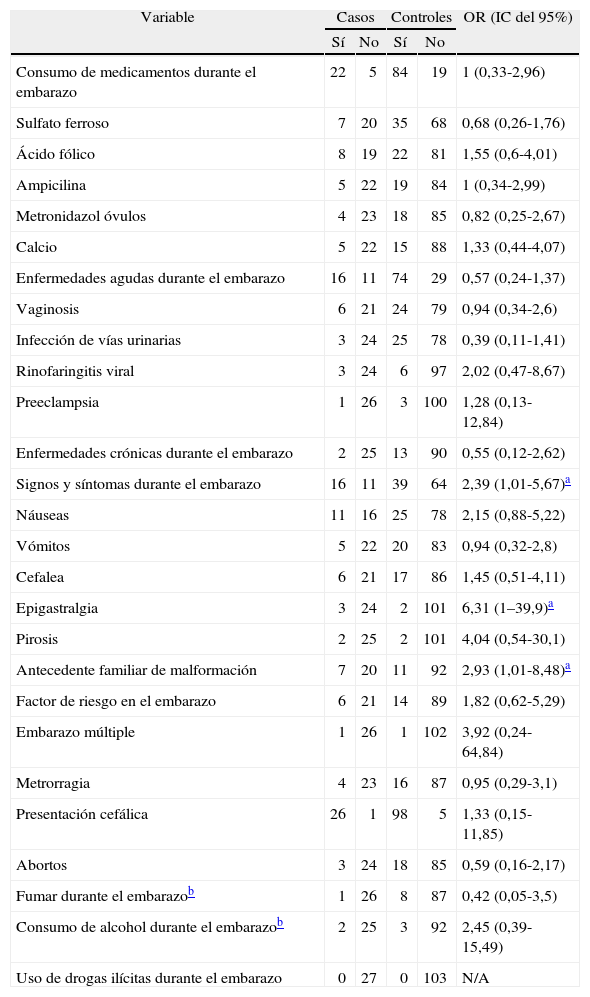Introducción y objetivos: Microtia es una malformación mayor del pabellón auricular que presenta un espectro que va desde la disminución leve del tamaño del pabellón o una de sus partes hasta la ausencia total del pabellón (anotia). Su prevalencia varía según la región del mundo en la cual se evalúe. Analizamos diferentes variables maternas, neonatales y familiares, entre casos y controles, en comparación con las de la literatura existente.
Métodos: Recolectamos información del Estudio Colaborativo Latinoamericano de Malformaciones Congénitas registrada en 2001–2006; encontramos 27 casos de microtia aislada, también recabamos información de 103 controles. Analizamos la información mediante la prueba de la t de Student y la odds ratio (OR).
Resultados: La distribución de la microtia fue: 3 (11,1 %) pacientes con microtia I, 19 (70,4 %) con microtia II y 2 (7,4 %) con microtia III. No había pacientes con anotia. La lateralidad más común fue el lado derecho. La proporción varones/mujeres fue de 1,7:1. Tener un peso al nacer ≤ 2.500g genera una OR de 3,25 (intervalo de confianza del 95 %, 1,11-9,58) para el desarrollo de microtia.
Conclusiones: La microtia puede tener relación directa o indirecta con la precipitación del inicio en el trabajo de parto. En futuros estudios los pacientes deberían tener un seguimiento a largo plazo para detectar posibles anomalías del espectro oculoauriculovertebral. También es importante realizar medidas antropométricas para aumentar la probabilidad de detección en casos de microtia de grado I e hipoplasia facial media y definir con mayor exactitud si la microtia aislada es la forma más leve del espectro oculoauriculovertebral.
Introduction and objectives: Microtia is a major malformation of the auricle, comprising a clinical spectrum ranging from a slight reduction in the size of the auricle or one of its parts to the complete absence of the pinna (anotia). Its prevalence varies according to the region of the world it is evaluated in. We analyzed a range of maternal, neonatal, and familial variables in a case group and a control group, and compared them with the existing literature.
Methods: We collected information from the Latin-American Collaborative Study on Congenital Malformations (ECLAMC) gathered between 2001 and 2006, where we found 27 cases of isolated microtia; we also collected information from 103 control subjects. Data were analyzed using Student'st and odds ratio (OR).
Results: Microtia distribution was 3 (11.1 %) patients with grade I microtia, 19 (70.4 %) with grade II microtia, 2 (7.4 %) with grade III microtia. We found no patients with anotia. Regarding laterality, the right side was involved more often. Male-to-female ratio was 1.7:1. Birthweight ≤ 2,500g produces an OR of 3.25 (95 % CI, 1.11-9.58) for the development of microtia.
Conclusions: Microtia may be directly or indirectly associated with the early onset of labour. Future studies should include long-term follow up of the patients in order to detect possible anomalies of the oculo-auriculo-vertebral spectrum. It is also important to take anthropometric measurements to increase the likelihood of detecting cases of grade I microtia and mid-face hypoplasia, and to define with greater accuracy whether isolated microtia is the mildest form of the oculo-auriculo-vertebral syndrome.
Artículo
Comprando el artículo el PDF del mismo podrá ser descargado
Precio 19,34 €
Comprar ahora







